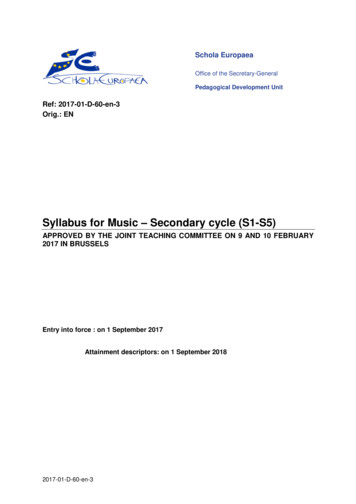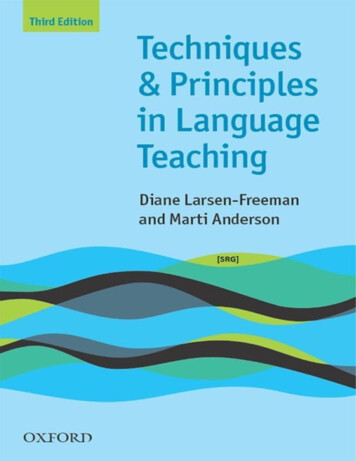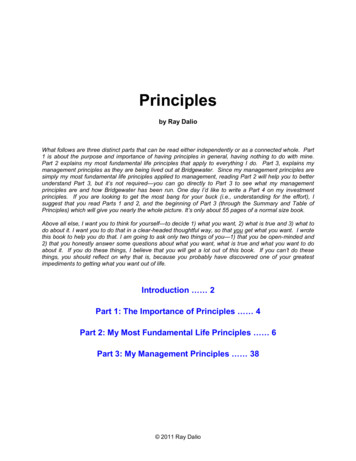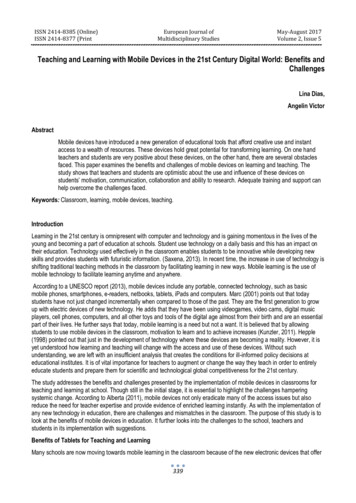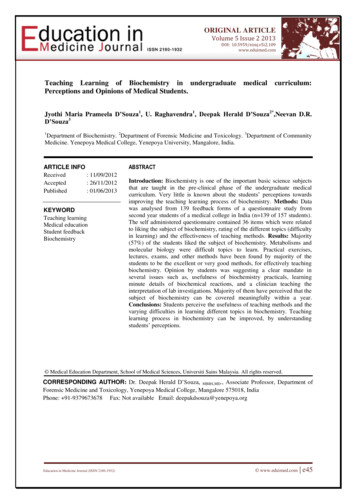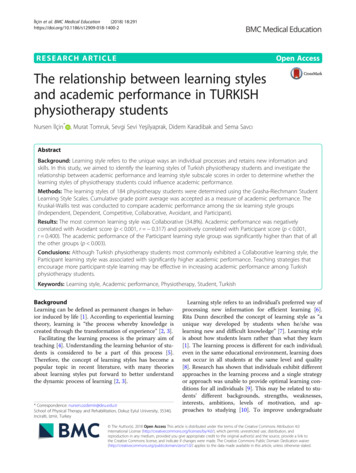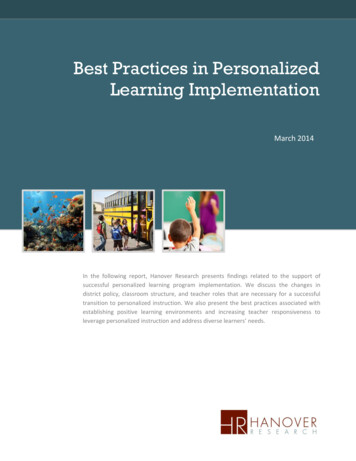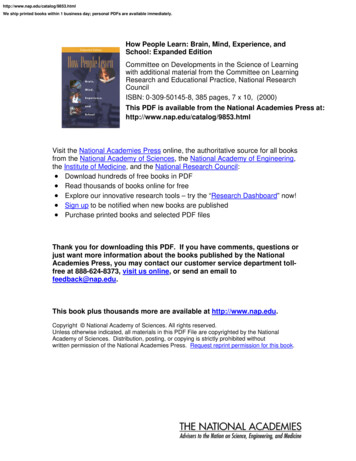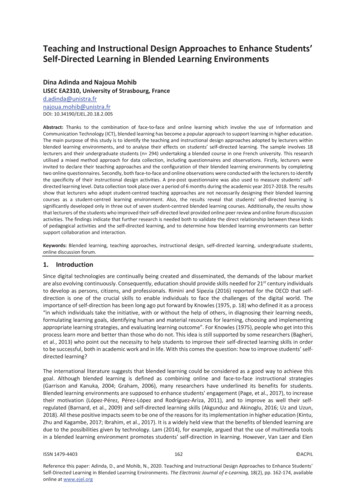
Transcription
The Praxis Study CompanionPrinciples of Learning andTeaching: Grades 7–125624www.ets.org/praxis
Welcome to the Praxis Study CompanionWelcome to the Praxis Study CompanionPrepare to Show What You KnowYou have been working to acquire the knowledge and skills you need for your teaching career. Now you areready to demonstrate your abilities by taking a Praxis test.Using the Praxis Study Companion is a smart way to prepare for the test so you can do your best on test day.This guide can help keep you on track and make the most efficient use of your study time.The Study Companion contains practical information and helpful tools, including: An overview of the Praxis tests Specific information on the Praxis test you are taking A template study plan Study topics Practice questions and explanations of correct answers Test-taking tips and strategies Frequently asked questions Links to more detailed informationSo where should you start? Begin by reviewing this guide in its entirety and note those sections that you needto revisit. Then you can create your own personalized study plan and schedule based on your individual needsand how much time you have before test day.Keep in mind that study habits are individual. There are many different ways to successfully prepare for yourtest. Some people study better on their own, while others prefer a group dynamic. You may have more energyearly in the day, but another test taker may concentrate better in the evening. So use this guide to develop theapproach that works best for you.Your teaching career begins with preparation. Good luck!Know What to ExpectWhich tests should I take?Each state or agency that uses the Praxis tests sets its own requirements for which test or tests you must take forthe teaching area you wish to pursue.Before you register for a test, confirm your state or agency’s testing requirements at www.ets.org/praxis/states.How are the Praxis tests given?Praxis tests are given on computer. Other formats are available for test takers approved for accommodations (seepage 50).The Praxis Study Companion2
Welcome to the Praxis Study CompanionWhat should I expect when taking the test on computer?When taking the test on computer, you can expect to be asked to provide proper identification at the testcenter. Once admitted, you will be given the opportunity to learn how the computer interface works (how toanswer questions, how to skip questions, how to go back to questions you skipped, etc.) before the testing timebegins. Watch the What to Expect on Test Day video to see what the experience is like.Where and when are the Praxis tests offered?You can select the test center that is most convenient for you. The Praxis tests are administered through aninternational network of test centers, which includes Prometric Testing Centers, some universities, and otherlocations throughout the world.Testing schedules may differ, so see the Praxis web site for more detailed test registration information at www.ets.org/praxis/register.The Praxis Study Companion3
Table of ContentsTable of ContentsThe Praxis Study Companion guides you through the steps to success1. Learn About Your Test.5Learn about the specific test you will be taking2. F amiliarize Yourself with Test Questions. 14Become comfortable with the types of questions you’ll find on the Praxis tests3. Practice with Sample Test Questions. 18Answer practice questions and find explanations for correct answers4. Determine Your Strategy for Success. 28Set clear goals and deadlines so your test preparation is focused and efficient5. Develop Your Study Plan. 31Develop a personalized study plan and schedule6. Review Study Topics. 35Review study topics with questions for discussion7. Review Smart Tips for Success. 48Follow test-taking tips developed by experts8. Check on Testing Accommodations. 50See if you qualify for accommodations to take the Praxis test9. Do Your Best on Test Day. 51Get ready for test day so you will be calm and confident10. Understand Your Scores. 53Understand how tests are scored and how to interpret your test scoresAppendix: Other Questions You May Have . 55The Praxis Study Companion4
Step 1: Learn About Your Test1. Learn About Your TestLearn about the specific test you will be takingPrinciples of Learning and Teaching: Grades 7–12 (5624)Test at a GlanceTest NamePrinciples of Learning and Teaching: Grades 7–12Test Code5624Time2 hoursNumber of Questions70 selected-response questions, 4 constructed-response questionsFormatSelected-response; constructed-response questions related to two case historiesTest DeliveryComputer deliveredContent CategoriesIVIVIIIIIApprox. Numberof SelectedresponseQuestionsApprox. Numberof ConstructedresponseQuestionsApprox.Percentage ofTestI. Students as Learners2122.5%II. Instructional Process2122.5%III. Assessment1415%IV. Professional DevelopmentLeadership, andCommunity1415%V. Analysis of InstructionalScenarios4Students as Learners1–2Instructional Process1–2Assessment0–1Professional Development,Leadership, andCommunity0–125%Pacing and Special Tips – In allocating time on this assessment, it is expected that about 70 minutes will bespent on the selected-response section and about 50 minutes will be spent on the constructed-responsesection; the sections are not independently timed.The Praxis Study Companion5
Step 1: Learn About Your TestAbout This Test3. Understands the concepts and terms relatedto a variety of learning theoriesThe purpose of this test is to assess a new teacher’sknowledge and understanding of educationalpractices foundational to beginning a career as aprofessional educator. The test content assesses keyindicators of the beginning educator’s knowledgeof topics such as human development, learningprocesses, instructional processes, diverse learners,educational psychology, and professional issues.Examinees taking Principles of Learning and Teaching(PLT) will typically have completed, or will have nearlycompleted, an undergraduate education program.Each test includes questions that apply specifically tothe stated grade range of the test as well as some thatare universal to all grade levels.a.b.c.d.e.f.g.4. Knows the distinguishing characteristics of thestages in each domain of human development(i.e., cognitive, physical, social, and moral)a.b.a.Test Specificationsb.Test specifications in this chapter describe theknowledge and skills measured by the test. Studytopics to help you prepare to answer test questionscan be found on page 35.c.d.B.Students as LearnersA.Student Development and the LearningProcessc.1. Understands that a number of variables affecthow individual students learn and performa.knows how knowledge is constructedknows a variety of means by which skillsare acquiredunderstands a variety of cognitiveprocesses and how they are developed2. Knows the major contributions of foundationaltheorists to educationa.relates the work of theorists to educationalcontexts–– Bandura–– Bruner–– Dewey–– Piaget–– Vygotsky–– Kohlberg–– BloomThe Praxis Study Companiondefines the relationship between learningtheory and human developmentprovides examples of how learning theoryis impacted by human developmentuses knowledge of learning theory to solveeducational problemsuses knowledge of human development tosolve educational problemsStudents as Diverse Learners1. Understands the theoretical foundations ofhow students learna.b.describes the characteristics of a typicalchild in each stage and each domainrecognizes typical and atypical variancewithin each stage and each domain5. Understands how learning theory and humandevelopment impact the instructional processThis test may contain some questions that will notcount toward your lf-regulationzone of proximal developmentclassical and operant conditioningb.identifies a number of variables that affecthow students learn and perform–– gender–– culture–– socioeconomic status–– prior knowledge and experience–– motivation–– self-confidence, self-esteem–– cognitive development–– maturity–– languageprovides examples of how variables mightaffect how students learn and perform6
Step 1: Learn About Your Test2. Recognizes areas of exceptionality and theirpotential impact on student learninga.b.2. Understands the implications of foundationalmotivation theories for instruction, learning,and classroom managementidentifies areas of exceptionality–– cognitive–– auditory–– visual–– motor/physical–– speech/language–– behavioralexplains a variety of ways exceptionalitiesmay impact student learninga.b.3. Understands the implications and applicationof legislation relating to students withexceptionalities on classroom practicea.b.3. Knows principles and strategies for classroommanagementidentifies the provisions of legislationrelevant to students with exceptionalities–– Americans with Disabilities Act (ADA)–– Individuals with Disabilities EducationAct (IDEA)–– Section 504, Rehabilitation Act (504)explains how the provisions of legislationrelating to students with exceptionalitiesaffect classroom practicea.b.c.d.e.4. Recognizes the traits, behaviors, and needs ofintellectually gifted studentsa.b.c.6. Knows a variety of approaches foraccommodating students with exceptionalitiesin each phase of the education processd.b.C.recognizes students with exceptionalitiesrequire particular accommodationsknows how to modify instruction,assessment, and communication methodsto meet a recognized needStudent Motivation and Learning Environment1. Knows the major contributions of foundationalbehavioral theorists to educationa.relates the work of behavioral theorists toeducational contexts–– Thorndike–– Watson–– Maslow–– Skinner–– EriksonThe Praxis Study Companionknows how to develop classroom routinesand proceduresknows how to maintain accurate recordsknows how to establish standards ofconductknows how to arrange classroom spacerecognizes ways of promoting a positivelearning environment4. Knows a variety of strategies for helpingstudents develop self-motivation5. Recognizes that the process of Englishlanguage acquisition affects the educationalexperience of English language learners (ELLs)a.defines terms related to foundationalmotivation theory–– self-determination–– attribution–– extrinsic/intrinsic motivation–– cognitive dissonance–– classic and operant conditioning–– positive and negative reinforcementrelates motivation theory to instruction,learning, and classroom managementassigning valuable tasksproviding frequent positive feedbackincluding students in instructionaldecisionsde-emphasizing gradesII. Instructional ProcessA.Planning Instruction1. Understands the role of district, state, andnational standards and frameworks ininstructional planninga.b.c.understands the theoretical basis ofstandards-based educationknows resources for accessing district,state, and national standards andframeworksunderstands how standards andframeworks apply to instructional planning7
Step 1: Learn About Your Test2. Knows how to apply the basic concepts ofpredominant educational theoriesa.b.c.d.e.understands the basic concepts ofcognitivism–– schema–– information processing–– mappingunderstands the basic concepts of sociallearning theory–– modeling–– reciprocal determinism–– vicarious learningunderstands the basic concepts ofconstructivism–– learning as experience–– problem-based learning–– zone of proximal development–– scaffolding–– inquiry/discovery learningunderstands the basic concepts ofbehaviorism–– conditioning–– intrinsic and extrinsic rewards–– reinforcement–– punishmentknows how to apply the basic concepts ofbehaviorism, constructivism, social learningtheory, and cognitivism to instructionalcontexts6. Is aware of the need for and is able to identifyvarious resources for planning enrichment andremediationa.b.c.7. Understands the role of resources andmaterials in supporting student learninga.b.c.3. Understands how scope and sequence affectinstructional planninga.b.c.d.defines and provides examples of scopedefines and provides examples ofsequenceunderstands the relationship betweenscope and sequence and standards oflearningunderstands the role of scope andsequence in curriculum planningd.e.4. Knows how to select content to achieve lessonand unit objectives5. Knows how to develop observable andmeasurable instructional objectives in thecognitive, affective, and psychomotor domainsa.b.c.d.distinguishes among the different learningdomainsknows how to apply Bloom’s Taxonomy tothe development of instructionalobjectivesknows how to describe observablebehaviorknows how to describe measurableoutcomesThe Praxis Study Companionidentifies when remediation is appropriateidentifies when enrichment is appropriateidentifies a variety of resources for locating,adapting, or creating enrichment andremediation activitiesf.g.identifies and explains the uses of a varietyof resources and materials that supportstudent learning–– computers, the Internet, and otherelectronic resources–– library collection (books, magazines,pamphlets, reference works)–– videos, DVDs–– artifacts, models, manipulatives–– guest speakers and communitymembers–– knows how to develop lessons as part ofthematic and/or interdisciplinary unitsunderstands the basic concepts ofthematic instructionunderstands the components of thematicunits–– selecting a theme–– designing integrated learning activities–– selecting resources–– designing assessmentsunderstands the basic concepts ofinterdisciplinary instructionunderstands the components ofinterdisciplinary units–– collaborating–– generating applicable topics–– developing an integrative framework–– planning instruction for each discipline–– designing integrative assessment–– recognizes their role in collaboratingwith instructional partners ininstructional planningidentifies a variety of instructional planningpartners–– special education teachers–– library media specialists–– teachers of the gifted and talented–– IEP team members–– paraeducatorsdescribes the roles each partner plays incollaborative activities8
Step 1: Learn About Your TestB.Instructional Strategiese.1. Understands the cognitive processesassociated with learninga.b.c.d.e.f.g.h.critical thinkingcreative thinkingquestioninginductive and deductive reasoningproblem solvingplanningmemoryrecall4. Knows a variety of strategies for encouragingcomplex cognitive processesa.identifies complex cognitive processes–– concept learning–– problem solving–– metacognition–– critical thinking–– transferb.knows instructional activities specific to thedevelopment of complex cognitiveprocesses–– distinguishing fact from opinion–– comparing and contrasting–– detecting bias–– predicting–– categorizing–– analyzing–– sequencing–– summarizing–– inferring–– decision making–– evaluating–– synthesizing–– generalizing2. Understands the distinguishing features ofdifferent instructional modelsa.describes a variety of instructional models–– direct–– indirect–– independent–– experiential–– interactive3. Knows a variety of instructional strategiesassociated with each instructional modela.identifies instructional strategies associatedwith direct instruction–– explicit teaching–– drill and practice–– lecture–– demonstrations–– guides for reading, listening, viewingb.identifies instructional strategies associatedwith indirect instruction–– problem solving–– inquiry–– case studies–– concept mapping–– reading for meaning–– cloze proceduresidentifies instructional strategies associatedwith independent instruction–– learning contracts–– research projects–– learning centers–– computer mediated instruction–– distance learningidentifies instructional strategies associatedwith experiential and virtual instruction–– field trips–– experiments–– simulations–– role play–– games–– observationsc.d.The Praxis Study Companionidentifies instructional strategies associatedwith interactive instruction–– brainstorming–– cooperative learning groups–– interviews–– discussions–– peer practice–– debates5. Knows a variety of strategies for supportingstudent learninga.identifies and explains uses of strategies forsupporting student learning–– modeling–– developing self-regulation skills–– scaffolding–– differentiating instruction–– guided practice–– coaching9
Step 1: Learn About Your Test6. Knows basic strategies for promoting students’development of self-regulatory skillsa.b.knows how to support students in–– setting goals–– managing time–– organizing information–– monitoring progress–– reflecting on outcomes–– establishing a productive workenvironment–– understands the design of differentgroup configurations for learningdescribes different group configurations–– whole-class–– small-group–– independent learning–– one-on-one–– pair/share7. Understands the use and implications ofdifferent grouping techniques and strategiesa.explains the uses, strengths, and limitationsof a variety of grouping techniques–– cooperative learning–– collaborative learning–– heterogeneous grouping–– homogeneous grouping–– multi-age grouping–– grouping by gender12. Recognizes the role of teachable moments ininstructiona.b.C.Questioning Techniques1. Knows the components of effectivequestioninga.b.c.d.e.f.g.h.a.9. Understands the concept of monitoring andadjusting instruction in response to studentfeedbackb.explains the instructional purposes ofmonitoring and adjusting instructionknows strategies for monitoring andadjusting instruction10. Recognizes the purpose of reflecting upon,analyzing, and evaluating the effectiveness ofinstructional strategies11. Knows the characteristics of different types ofmemory and their implications for instructionalplanning and student learninga.b.distinguishes among the different types ofmemory–– short term–– long termconsiders the characteristics and effects ofmemory on student learning whenplanning instructionThe Praxis Study Companionallowing think/wait timehelping students articulate their ideasrespecting students’ answershandling incorrect answersencouraging participationestablishing a non-critical classroomenvironmentpromoting active listeningvarying the types of questions2. Understands the uses of questioning8. Knows how to select an appropriate strategyfor achieving an instructional objectivea.defines and provides examples of ateachable momentunderstands the uses of the teachablemomentexplains and provides examples of differentpurposes of questioning–– developing interest and motivatingstudents–– evaluating students’ preparation–– reviewing previous lessons–– helping students set realisticexpectations–– engaging students in discussion–– determining prior knowledge–– preparing students for what is to belearned–– guiding thinking–– developing critical and creative thinkingskills–– checking for comprehension or level ofunderstanding–– summarizing information–– stimulating students to pursueknowledge on their own3. Knows strategies for supporting students inarticulating their ideasa.explains and provides examples ofstrategies for supporting students inarticulating their ideas–– verbal and non-verbal prompting–– restatement–– reflective listening statements–– wait time10
Step 1: Learn About Your Test4. Knows methods for encouraging higher levelsof thinkinga.explains and provides examples ofmethods for encouraging students’ higherlevels of thinking, thereby guidingstudents to–– reflect–– challenge assumptions–– find relationships–– determine relevancy and validity ofinformation–– design alternate solutions–– draw conclusions–– transfer knowledge5. Knows strategies for promoting a safe andopen forum for discussiona.D.knows basic techniques for establishingand maintaining standards of conduct fordiscussions–– engaging all learners–– creating a collaborative environment–– respecting diverse opinions–– supporting risk takingCommunication Techniques1. Understands various verbal and nonverbalcommunication modesa.III. AssessmentA.Assessment and Evaluation Strategies1. Understands the role of formal and informalassessment in informing the instructionalprocessa.b.2. Understands the distinctions among thedifferent types of assessmenta.a.b.2. Is aware of how culture and gender can affectcommunicationb.audio and visual aidstext and digital resourcesInternet and other computer-based tools4. Understands effective listening strategiesa.explains and provides examples of activelistening strategies–– attending to the speaker–– restating key points–– asking questions–– interpreting information–– providing supportive feedback–– being respectfulThe Praxis Study Companionknows how to create assessments in avariety of formatsis able to select an assessment format tomeet a specific instructional objective4. Knows how to select from a variety ofassessment tools to evaluate studentperformancea.a.b.c.defines and provides uses and examples offormative, summative, and diagnosticassessment3. Knows how to create and select anappropriate assessment format to meetinstructional objectivesexplains and provides examples of–– body language–– gesture–– tone, stress, and inflection–– eye contact–– facial expression–– personal space3. Knows how to use various communicationtools to enrich the learning environmentdefines and provides uses and examples offormal and informal assessment modesexplains a variety of ways the results offormal and informal assessment are used tomake educational decisionsknows a variety of assessment tools, theiruses, strengths, and limitations–– rubrics–– analytical checklists–– scoring guides–– anecdotal notes–– continuumsis able to select an assessment toolappropriate for quantifying the results of aspecific assessment5. Understands the rationale behind and the usesof students’ self and peer assessmenta.b.c.defines and provides uses and examples ofstudent self-assessment modesdefines and provides uses and examples ofpeer assessment modesexplains the strengths and limitations ofself and peer assessment modes11
Step 1: Learn About Your Test6. Knows how to use a variety of assessmentformatsa.b.B.describes and provides uses, strengths, andlimitations of a variety of assessmentformats–– essay–– selected response–– portfolio–– conference–– observation–– performanceis able to select an assessment formatappropriate to a specific educationalcontextAssessment Tools1. Understands the types and purposes ofstandardized testsa.b.explains the uses of the different types ofstandardized tests–– achievement–– aptitude–– abilityrecognizes the data provided by thedifferent types of standardized tests2. Understands the distinction between normreferenced and criterion-referenced scoringa.b.explains the uses of norm-referenced andcriterion-referenced testsexplains data provided by a normreferenced and a criterion-referenced test3. Understands terminology related to testingand scoringa.defines and explains terms related totesting and scoring–– validity–– reliability–– raw score–– scaled score–– percentile–– standard deviation–– mean, mode, and median–– grade-equivalent scores–– age-equivalent scores4. Understands the distinction between holisticand analytical scoringa.b.describes holistic scoring and analyticalscoringidentifies an educational context for eachThe Praxis Study Companion5. Knows how to interpret assessment results andcommunicate the meaning of those results tostudents, parents/caregiver, and schoolpersonnela.b.understands what scores and testing dataindicate about a student’s ability, aptitude,or performanceis able to explain results of assessmentsusing language appropriate for theaudienceIV. Professional Development, Leadership, andCommunity1. Is aware of a variety of professionaldevelopment practices and resourcesa.b.c.d.e.f.g.h.i.j.professional literatureprofessional associationsworkshopsconferenceslearning communitiesgraduate coursesindependent researchinternshipsmentorsstudy groups2. Understands the implications of research,views, ideas, and debates on teachingpracticesa.b.c.knows resources for accessing research,views, ideas, and debates on teachingpracticesinterprets data, results, and conclusionsfrom research on teaching practicesis able to relate data, results, andconclusions from research and/or views,ideas, and debates to a variety ofeducational situations3. Recognizes the role of reflective practice forprofessional growtha.b.defines the purposes of reflective practiceknows a variety of activities that supportreflective practice–– reflective journal–– self and peer assessment–– incident analysis–– portfolio–– peer observation–– critical friend12
Step 1: Learn About Your Test4. Is aware of school support personnel whoassist students, teachers, and familiesa.b.c.d.e.f.g.guidance counselorsIEP team membersspecial education teachersspeech, physical, and occupationaltherapistslibrary media specialiststeachers of the gifted and talentedparaeducators5. Understands the role of teachers and schoolsas educational leaders in the greatercommunitya.b.c.d.role of teachers in shaping and advocatingfor the professionperceptions of teacherspartnerships with parents and familymemberspartnerships with the community6. Knows basic strategies for developingcollaborative relationships with colleagues,administrators, other school personnel,parents/caregivers, and the community tosupport the educational processa.knows the elements of successfulcollaboration–– Developing an action plan–– Identifying the stakeholders–– Identifying the purpose of thecollaboration–– Supporting effective communication–– Seeking support7. Understands the implications of majorlegislation and court decisions relating tostudents and teachersa.b.c.d.e.f.g.h.i.equal accessprivacy and confidentialityFirst Amendment issuesintellectual freedommandated reporting of child neglect/abusedue processliabilitylicensing and tenurecopyrightThe Praxis Study Companion13
Step 2: Familiarize Yourself with Test Questions2. Familiarize Yourself with Test QuestionsBecome comfortable with the types of questions you’ll find on the Praxis testsThe Praxis assessments include a variety of question types: constructed response (for which you write aresponse of your own); selected response, for which you select one or more answers from a list of choices ormake another kind of selection (e.g., by clicking on a sentence in a text or by clicking on part of a graphic); andnumeric entry, for which you enter a numeric value in an answer field. You may be familiar with these questionformats from taking other standardized tests. If not, familiarize yourself with them so you don’t spend timeduring the test figuring out how to answer them.Understanding Computer-Delivered QuestionsQuestions on computer-delivered tests are interactive in the sense that you answer by selecting an optionor entering text on the screen. If you see a format you are not familiar with, read the directions carefully. Thedirections always give clear instructions on how you are expected to respond.For most questions, you respond by clicking an oval to select a single answer from a list of answer choices.However, interactive question types may also ask you to respond by: Clicking more than one oval to select answers from a list of choices. Typing in an entry box. When the answer is a number, you may be asked to enter a numerical answer.Some questions may have more than one place to enter a response. Clicking check boxes. You may be asked to click check boxes instead of an oval when more than onechoice within a set of answers can be selected. Clicking parts of a graphic. In some questions, you will select your answers by clicking on a location (orlocations) on a graphic such as a map or chart, as opposed to choosing your answer from a list. Clicking on sentences. In questions with reading passages, you may be asked to choose your answers byclicking on a sentence (or sentences) within the reading passage. Dragging and dropping answer choices into targets on the screen. You may be asked to select answersfrom a list of choices and drag your answers to the appropriate location in a table, paragraph of text orgraphic. Selecting answer choices from a drop-down menu. You may be asked to choose answers by selectingchoices from a drop-down menu (e.g., to complete a sentence).Remember that with every question you will get clear instructions.Perhaps the best way to understand computer-delivered questions is to view the Computer-delivered TestingDemonstration on the Praxis web site to learn how a computer-delivered test works and see examples ofsome types of questions you may encounter.The Praxis Study Companion14
Step 2: Familiarize Yourself with Test QuestionsUnderstanding Selected-Response QuestionsMany selected-response questions begin with the phrase “which of the following.” Take a look at this example:Which of the following is a flavor made from beans?(A) Strawberry(B) Cherry(C) Vanilla(D) MintHow would you answer this question?All of the answer choices are flavors. Your job is to decide which of the flavors is the one made from beans.Try following these steps to select the correct answe
Using the Praxis Study Companion is a smart way to prepare for the test so you can do your best on test day. This guide can help keep you on track and make the most efficient use of your study time. The Study Companion contains practical information and he


